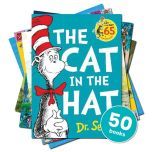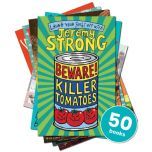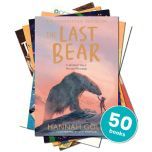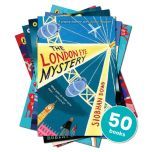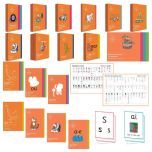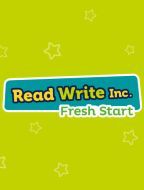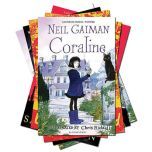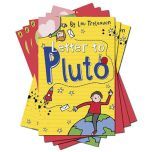Meet the Requirements of the new Reading Framework with Badger Learning
The government’s Reading Framework first published in 2021 has now been updated. A considerable amount of new information has been provided in the 2023 update. The document originally focused on Reception and key stage one, but now contains advice for developing reading in key stage 2 and 3. The introduction to the document states that its key objective is “to help schools to meet the expectations set out in the Early Years Foundation Stage (EYFS) statutory framework and the national curriculum.” At over 170 pages long, it is a lengthy read containing detailed advice divided into thirteen sections. The following overview highlights its key content and implications for the teaching of reading, together with just the right books to help you meet these new requirements.
Section 1: The Importance of Reading and a Conceptual Model
This section identifies how enjoyment of reading positively affects academic performance citing irrefutable evidence such as the 2021 Progress in International Reading Literacy Study (PIRLS) data for England which “showed that the pupils who said they liked reading the most scored, on average, 34 points more than those who said they did not like reading.” It also describes the conceptual model of reading which informs the national curriculum discussing word reading, comprehension and the correlation between them.
Section 2: Language Comprehension in Reception and Key Stage 1
The focus here is on the importance of creating a language-rich environment for pupils in Reception and key stage 1. It reminds educators that in the national curriculum for English and the EYFS framework, there is an emphasis on spoken language throughout.
Activities such as enjoying poems and rhymes are highlighted. The emphasis is not only on deliberately expanding pupil’s vocabulary but also on developing their listening and conversational skills. Practices that reduce interaction such as focusing on collecting evidence and continually asking for hands up are frowned upon.
The following carefully chosen collections provide you with all you need to place poetry firmly within the reading diets of the pupils in your school:
The guidance also discusses story time in Reception and Year 1 and 2 and how to choose stories and non-fiction. It suggests schools decide on core ‘read aloud’ stories and non-fiction and recommends seeking the advice of a specialist if needed. Here at Badger Learning, we offer carefully curated collections for all age groups. See below for our 50 recommended reads for year groups in Reception and key stage 1:
50 Recommended Reads for Reception
50 Recommended Reads for Year 1
50 Recommended Reads for Year 2
Further advice is given on reading stories, discussing stories, bringing attention to vocabulary and giving pupils the opportunity to dramatise stories through role-play. Badger Learnings’ KS1 Enjoy Guided Reading fiction range contains high-quality stories and picture books with accompanying teacher notes which include guidance to help elicit discussion and develop understanding of vocabulary and ideas for role play. For more information see below:
Finally, advice on book corners is given with a strong message that it is not the decorative aspect of the book corner that is important – the priority is the books themselves.
Badger Learning’s Library and Reading Boxes are a cost-effective and hassle-free way to fill your bookshelves with high-quality books that deserve to be there and will help pupils put in the reading miles:
Section 3: Word Reading and Spelling
This section details the principles underpinning the teaching of phonics and the mechanics of decoding. It stresses the importance of schools choosing and being faithful to a systematic synthetics phonics programme. The guidance advises that high quality phonics teaching does not include activities such “as painting, colouring, modelling, playing in the sand and water tray” as these are not particularly useful or efficient ways to develop phonics skills. Badger Learning stocks a range of commercially available SSPs that have been validated by the Department for Education such as Bug Club Phonics, Little Wandle, Essential Letters and Sounds, Read Write Inc. Phonics and Rocket Phonics. Browse phonics resources here.
A new reading scheme is a significant investment for any school, so if you are still deciding which option is the right one for your school we hope the following information will be of help:
What's the Best Reading Scheme for My School?
Phonics Mapping Support Documents.
Compare Reading Scheme Sample Pages by Book Band.
If you are interested in information about the phonics focus during OFSTED’s Reading Deep Dive which is part of the New Ofsted Education Inspection Framework (EIF) you may find the following Badger Learning Blog useful:
Section 4: Developing Fluency
This section focuses on the importance of fluency. According to the guidance, developing fluency using ‘decodable books’ can be achieved through rereading. Once students are past this stage, rereading is still seen as an important tool. The guidance states “Pupils might re-read a passage from a story read aloud in an English lesson, a section from a non-fiction text from a history lesson or a demanding poem that all the class has learnt by heart”. Strategies such as teacher modelling, echo reading and choral reading are also recommended.
Section 5: Pupils Who Need the Most Support
For pupils who need support in reading the guidance advises the following:
- Pupils who need the most support in phonics should be identified early and given extra practice. The framework defines this as ‘Keeping up from the start’.
- Support might happen individually or in groups.
- Recognise that “Consensus is growing among academics and teachers that the best reading instruction for pupils with SEND is SSP, taught by direct instruction.”
- When working with students who need extra support in key stage 2 and 3, it is important to identify whether they need support in decoding or fluency.
- Support should be age appropriate.
- Comprehension skills can be built by reading more.
- It may not always be possible to timetable reading interventions outside of curriculum time. Students may need to miss some lessons to receive reading support but “Providing catch-up teaching for word and text reading is vital, however difficult it may be to organise sufficient time, space and staff.”
Resources for older pupils, in primary and secondary schools, who continue to struggle with reading and need to be taught through an age-appropriate systematic synthetic phonics programme can be found below:
The following SSP has been specifically created to support pupils with SEND, to ensure just the right level of challenge for each child using a graduated approach:
Badger Learning also offer a wide range of engaging materials for reluctant and struggling readers at primary and secondary levels. For more information see the links below:
Struggling or Reluctant Reader Books for Primary
Struggling or Reluctant Reader Books for Secondary
Section 6: What Skilled Readers Can Do
This section discusses the mental processes which occur when reading and describes how a student can move from decoding to becoming a fluent, enthusiastic skilled reader. The guidance highlights that becoming a skilled reader is largely dependent on what it identifies as “three strands of reading – being able to read, choosing to read and spending time reading”.
Section 7: Choosing and Organising Books
This section discusses the organisation of decodable books within the schools SSP programme stating that pupils learning to read “should be reading books that are consistent with their developing phonic knowledge”. If you would like to explore SSP resources browse here.
The guidance acknowledges that suggesting books for pupils to read once they are past the decoding stage is not as straightforward. It offers the following recommendations regarding books bands: “If schools organise books into book band levels, teachers should select which of these books they think their pupils will enjoy and be able to read successfully and introduce these to specific groups of pupils in book club time.” It warns against restricting pupil’s choice by confining them to choose books from a narrow level or colour band.
At Badger Learning, we recognise that teachers find book bands useful because they help them to select books that are at an appropriate reading level. We agree that it would be disheartening for pupils to be faced with a meagre selection of uninspiring books when they reach a certain level and therefore ensure our book band collections contain an extensive range of high-quality fiction and non-fiction books. For more information and to browse our book band collections see below:
The reading framework specifically recommends considering the following categories when choosing and organising books for English lessons, independent reading, story times and book clubs:
- Picture books — including graphic novels for older pupils.
- Page-turners, long and short - —anything that encourages pupils to read is viewed as important. “Teachers should provide books that are likely to give the most pleasure, so that all pupils feel encouraged to put in the reading miles before they read more challenging books.”
- Literature — children “should read, listen to and talk about contemporary and classic writing by a broad and diverse range of authors, where the depth of ideas and language allows for rich discussion and study.”
- Hi-lo books — books with a high interest age and a low reading age. The guidance states “Pupils can accumulate background knowledge across the whole curriculum, learning a lot about a little under the radar of easy reading.”
Making decisions about book stock and categorising books can be difficult and time consuming. Badger Learning can help with this. We offer book collections organised into numerous categories which have been expertly hand-picked to precisely match young readers by age group or theme. For more information see below:
We also have a fantastic range of high-lo books and graphic novels. We agree with the framework guidance which advises that hi-lo books and graphic novels are motivating for advanced and older readers as well as young or struggling readers. For details about our new paired hi-lo fact and fiction range and our new graphic novel fiction series see below:
WOW! Paired Fiction & Non-Fiction — Complete Collection Turquoise to Gold
Section 8: Developing a Reading for Pleasure Culture
The guidance stresses the importance of “embedding a school culture that values and supports reading for pleasure”. Students need to “need to put in the ‘reading miles’ to become readers” therefore schools should nurture the reading habit using a strategic approach. Schools must ensure all pupils “have the time and motivation to read widely and often, as well as opportunities to discuss their reading.” This includes students in key stage 3.
Strategies for creating a reading culture include:
- Developing book clubs — whole class sessions in which books are introduced, recommended and discussed.
- Considering the impact of peer influencers. According to the guidance, if well-liked pupils share their opinions about books this can influence others.
- Enabling students to choose their reading materials with support where necessary.
- Not relying on extrinsic motivators such as rewards and certificates to develop reading habits; instead, focusing on developing intrinsic motivation so that students read because they want to and are interested in books.
- Avoiding requiring students to answer questions about every single book they read as this could be demotivating.
- Setting aside class reading time. At secondary level “schools should ensure that pupils have a book with them throughout the day, chosen in library time (or book club).”
- Ensuring that reading aloud is viewed as priority not an indulgence. “It is important that pupils have the opportunity to listen to a wide range of whole books during their time at school”.
Support school staff to promote reading for pleasure with book collections hand-picked by our primary school specialists as the most Likely to get children into reading and keep them there:
Section 9: Reading Across the Curriculum
This section reminds teachers that teaching reading is not just something that should be confined to English lessons and that “Reading across the curriculum supports the knowledge and vocabulary to be learnt each subject.” Although “the knowledge being taught, however, should always be the core purpose of the lesson” teachers should draw attention to text features and identify and explain new vocabulary when reading texts in different subjects. The guidance also emphasises the importance of the spoken language element of the national curriculum in all lessons. Paired talk in particular is recommended as a strategy that ensures all pupils contribute.
Section 10: Teaching Reading in the English Lesson
This section discusses the explicit teaching of reading through instruction and considers how this should be done effectively. It advises that English leads should ensure reading texts are “sequenced carefully and equip pupils with the ability to understand increasingly complex texts they may meet in later key stages.” The focus should be on children reading full texts “not just extracts”. The guidance reminds teachers that “reading lessons need to create readers, not just pupils who can read.” It is suggested that “reading lessons should focus on supporting pupils to construct a mental model of a specific text so that they understand its meaning.” The guidance warns against overanalysing and discussing a story whilst reading aloud to pupils warning that this can “break the spell a great story can cast.”
The elements of reading in English lessons are described as:
- The teacher reading aloud
- Pupils reading
- The teacher’s modelling and explanations
- Questioning
The guidance explains that during teacher modelling and explanation teachers might focus on a specific strategy. For example, teachers might do one of the following:
- Model how ideas in the text and ideas from pupils’ background knowledge are combined to make meaning
- Show how to decode unfamiliar words and then explain their meaning
- Comment on and consider the impact of specific words or phrases
- Model how a skilled reader fills in the gaps as they read
It states, “This approach can be used successfully in shared reading (with the whole class reading a text together), in small group reading” and also recommends its use during one-to-one reading sessions.
If you are looking for support for teaching whole class reading in key stage 2 you might find Badger Learning’s Enjoy Whole Class Reading series useful. This series includes carefully chosen contemporary and classic novels with teacher notes containing lesson plans. Lessons are structured so that they include reading aloud, teacher modelling and explanation, questioning and focus on a national curriculum objective. Plus, each lesson provides students with an opportunity to summarise, develop their vocabulary and discuss the text. See the link below to find out more:
If you are interested in materials to support small group reading in key stage 2, we offer a wide range of guided reading resources which feature books by popular authors, prize winners and authors from our literary heritage. The included teacher notes are designed to generate discussion and improve comprehension. See the link below to find out more:
For those pupils who are still struggling with decoding additional support is recommended. For lower attaining pupils who are past the decoding stage the framework advises that “limited and focused teaching of reading comprehension strategies (RCS) can be beneficial, particularly for some readers in upper key stages but these should be time limited”.
The Reading Framework states that teachers should not restrict the teaching of reading to the eight content domains that structure the key stage 2 assessments “whether they are repackaged as ‘reading skills’ (predicting, retrieving information, making inferences etc.), translated into child-friendly language, or shared as a mnemonic,”.
At Badger Learning we agree that teaching to the test “will restrict pupils’ access to the wider national curriculum and is likely to inhibit their enjoyment of reading.” All of our guided and shared reading resources are linked to the wider national curriculum reading objectives rather than just the content domains with an overriding focus on enabling students to enjoy reading, modelling and generating “high quality discussion”.
Section 11: National Assessments
This section provides details of the national assessments for English Including the:
- EYFS Profile
- Phonics Screening Check
- Key Stage 2 Assessments
Section 12: Leadership and Management of Reading
This part of the guidance discusses the responsibilities of headteachers and senior staff in primary and secondary schools in regard to manging reading. The framework states that leaders are required to “believe that all pupils can learn to read, regardless of their background, needs, abilities and age, and be determined to make this happen” and to “promote a culture of reading for pleasure, ensuring that the desire to read is at the core of the curriculum, including monitoring and evaluating provision regularly”.
Develop a clear vision for reading and the future of your school library by downloading ‘Inspirational Libraries: A Foundation for Success’. This free resource includes a presentation to get senior leaders and staff on board and a comprehensive action plan to start the ball rolling:
Inspirational Libraries: A Foundation for Success
Section 13: Supporting Pupils’ Reading in Key Stage 3
This section states that “This document’s key objective has been to help primary schools to make sure that their pupils start secondary school as confident and engaged readers, and to help secondary schools to teach any pupils who are not.”
It reiterates that it is important to identify pupils who need support when moving from primary to secondary school and that all key stage 3 teachers should be aware of who these pupils are. It contains links to other sections of the reading framework which explain the processes of learning to read and how struggling students can be supported.
The appendices of the document provide further information which expand on sections of the document and reinforce its central messages. Namely that reading is a crucial skill that is needed to succeed in all subjects. A firm foundation in phonics is the key to beginning a child’s reading journey, and on the path to becoming a successful reader, huge gains can be made through simply ensuring pupils are able to enjoy listening to, reading and discussing books.
Badger Learning offer phonics resources from Read Write Inc. Fresh Start that support secondary school pupils who need to recap on their phonics learning. As well as we also have a wide range of hi-lo books for secondary school students that are ideal to engage reluctant, struggling and dyslexic readers. These have been written by specialist authors who use a range of techniques to engage students in reading, along with design features such as dyslexia-friendly fonts, wider line spacing, shorter sentences and supportive illustrations.
You may also find further inspiration and ideas within our blog on Narrowing the Reading Gap in KS2:
Top 10 Tips to Narrow the Reading Gap in KS2

